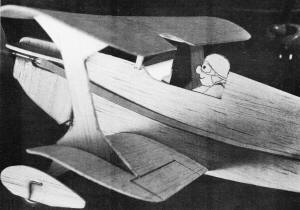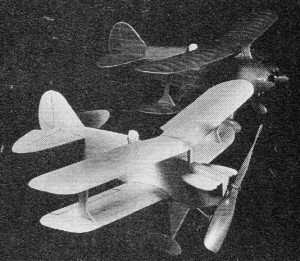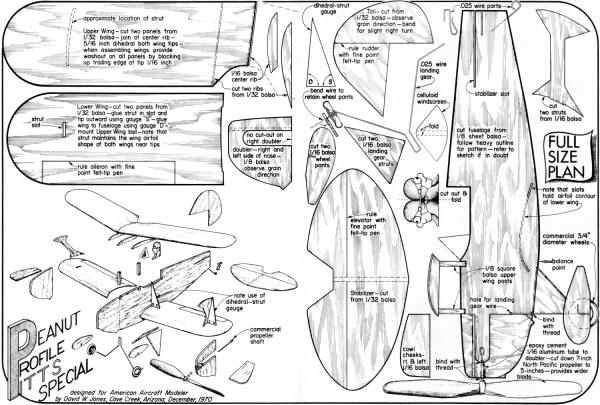|
Website visitor Douglas G. wrote to ask that I
scan and post this article from the September 1972 edition of American Aircraft Modeler. The Peanut-scale Pitts Special is another
in the series of "For the Tenderfoot" models that feature easy to build and easy to fly designs meant to help beginners be successful. They
would make excellent building subjects for modelers of any age even today and especially since nowadays the overwhelming number of models are
pre-built, making the art of constructing an airplane and trimming it to fly a scarce commodity in the modeling world.
For the Tenderfoot: Peanut Profile Pitts Special
 by David W. Jones by David W. Jones
During the past year the problem of flying scale model builders became evident when indoor flying scale models constructed with the super-skill
of microfilm specialists won-simply be-cause they flew with the greatest endurance times. They might as well have been flying stick models!
On the other hand, models which were constructed with scale fidelity in mind never made significant flight times.

Most popular homebuilt aerobatic bipe makes nifty looking and easy flying scale model. All construction details are on the
plans.
This situation has made it quite clear the basic challenge of both building flying scale models, where the two disciplines of flyability
and scale fidelity clash on a high technological plane, and judging competitions, where weighing the merits of a true miniature replica of a
full-scale craft is precariously balanced against the stopwatch. In short, what looked like a fun-type extension of the "dime-model" concept
of years ago, which should attract many thousands of enthusiastic modelers, has (as in other types of highly-specialized competition) become
a battle of the experts, leaving behind the average model builder who enjoys his hobby for its own merits and not necessarily for the high-powered
thrills that competition brings.
I usually feel that if I can get a rubber-powered scale model to climb in a gentle and stable manner and glide to a smooth landing, I have
succeeded royally. Citing more specifically from my recent experience, I decided to build a Peanut Scale model (13-in. maximum span) of a Pitts
Special simply because the shape of the craft is appealing and I knew I'd enjoy flying it for my own amusement. I used a drawing by Björn
Karlström distributed by Bill Hannan's "Graphics" which was in 3/8-in. to the foot scale. By doubling the drawing size to 3/4-in. scale, the
span was just a little over a foot and just right for a Peanut model.

So what if the built-up scale version is more elegant - the profile model is more fun. Note cut-down prop gives lots of blade
area in small diameter.
It took quite an enjoyable period of time to build the model which flies well enough to satisfy me, but while constructing it, I had the
thought that a profile version of the Pitts using l/B balsa for the fuselage and 1/32 balsa for the flying surfaces would take only about 1/100
the time to make and would be more durable and probably a bit more flyable. It was easy to trace the outlines and glue the parts together.
Weighing the effort-to-satisfaction ratio, I would say the Peanut Profile Pitts Special wins hands down over the admittedly more elegant
flying scale replica.
Since I found such joy in this alteration of the Peanut Scale concept, I wanted to see how others would take to it, so I took the time to
make these plans. Actually, there is another reason for drawing the plans. It occurred to me that using the general system of simple construction
I've shown here, almost any full-size flying machine can be ren-dered unto the "Peanut Profile" size. Who will be the first with a Peanut Profile
Spitfire? Or FW-190?
And should such models become a competition item. It is easy to see that the general construction dilutes the need for detailed scale authenticity
and there is a basic uniform flyability inherent in such designs. Since profile models can be built quickly. It is a natural for small club
activity.
Build yourself a flying armada and send snapshots of your air force to American Aircraft Modeler. Anything as fun as this should be shared
with others!

Peanut Profile Pitts Special Plans <click for larger version>
Notice:
The AMA Plans Service offers a
full-size version of many of the plans show here at a very reasonable cost. They
will scale the plans any size for you. It is always best to buy printed plans because
my scanner versions often have distortions that can cause parts to fit poorly. Purchasing
plans also help to support the operation of the
Academy of Model Aeronautics - the #1
advocate for model aviation throughout the world. If the AMA no longer has this
plan on file, I will be glad to send you my higher resolution version.
Try my Scale Calculator for
Model Airplane Plans.
Posted October 26, 2013
|



